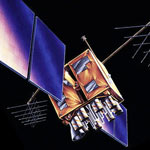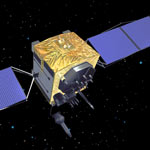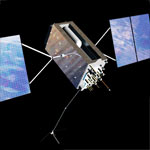Space Segment
On this page:
The GPS space segment consists of a constellation of satellites transmitting radio signals to users.
The United States is committed to maintaining the availability of at least 24 operational GPS satellites, 95% of the time.
To ensure this commitment, the U.S. Space Force has been flying 31 operational GPS satellites for well over a decade.
Constellation Arrangement
GPS satellites fly in medium Earth orbit (MEO) at an altitude of approximately 20,200 km (12,550 miles). Each satellite circles the Earth twice a day.

Enlarge
Expandable 24-Slot satellite constellation, as defined in the SPS Performance Standard.
The satellites in the GPS constellation are arranged into six equally-spaced orbital planes surrounding the Earth. Each plane contains four "slots" occupied by baseline satellites. This 24-slot arrangement ensures users can view at least four satellites from virtually any point on the planet.
The Space Force normally flies more than 24 GPS satellites to maintain coverage whenever the baseline satellites are serviced or decommissioned. The extra satellites may increase GPS performance but are not considered part of the core constellation.
Current and Future Satellite Generations
The GPS constellation is a mix of old and new satellites. The following table summarizes the features of the current and future generations of GPS satellites, including Block IIA (2nd generation, "Advanced"), Block IIR ("Replenishment"), Block IIR-M ("Modernized"), Block IIF ("Follow-on"), GPS III, and GPS IIIF ("Follow-on").
| Legacy Satellites | Modernized Satellites | |||
|---|---|---|---|---|
 |
 |
 |
 |
 |
| Block IIA | Block IIR | Block IIR-M | Block IIF | GPS III/IIIF |
| 0 operational |
6 operational |
7 operational |
12 operational |
6 operational |
|
|
|
|
|
As of July 3, 2023, there were a total of 31 operational satellites in the GPS constellation, not including the decommissioned, on-orbit spares.
For more up-to-date constellation status information, visit the NAVCEN website. Go there
Recent Developments
GPS III
- May 25, 2022: The Space Force set the fifth GPS III satellite to healthy (usable) status.
- Jun 28, 2021: The Space Force transferred Satellite Control Authority of the fifth GPS III satellite to the 2nd Space Operations Squadron.
View Space Force News Release - Jun 17, 2021: The Space Force and its partners successfully launched the fifth GPS III satellite into orbit.
View Space Force News Release - Apr 6, 2021: The fifth GPS III satellite arrived at Cape Canaveral Space Force Station for launch.
View Space Force news release - Dec 1, 2020: GPS III SV04 received operational acceptance.
View Space Force news release - Nov 5, 2020: The Space Force and its partners successfully launched the fourth GPS III satellite into orbit.
View Space Force news release - Jun 30, 2020: The Space Force successfully launched the third GPS III satellite into orbit.
View Space Force news release - Jun 2020: The Space Force completed the core mate of the eighth GPS III satellite and named it "Katherine Johnson."
View Space Force news release - May 2020: The Space Force performed the first GPS III maneuver.
View Space Force news release - Apr 2020: The Space Force rescheduled the launch of the third GPS III satellite from April to June 2020.
View Space Force news release - Mar 2020: The Space Force accepted control of the second GPS III satellite.
View Space Force news release - Jan 2020: The Air Force set the first GPS III satellite as healthy and active to users.
View space force news release
 Official U.S. government information about the
Global Positioning System (GPS) and related topics
Official U.S. government information about the
Global Positioning System (GPS) and related topics




